Physical Address
304 North Cardinal St.
Dorchester Center, MA 02124
The extensor mechanism of the knee plays an important role in normal lower extremity function. It is a complex of interconnected structures in the anterior knee that includes the quadriceps muscle group, quadriceps tendon, patella, patellar tendon, tibial tubercle, retinaculum, and adjacent soft tissues. Functionally, the extensor mechanism allows for knee extension when the leg is elevated, and acts as a stabilizer and decelerator when standing. In addition, the structures of the extensor mechanism play a vital role in patellofemoral stability.
Magnetic resonance imaging (MRI) is ideal for the evaluation of the bony and soft structures that comprise the extensor mechanism and is the focus of this chapter. MRI provides a comprehensive, multiplanar examination of the knee and allows for detailed evaluation of the bone and bone marrow, articular cartilage, and surrounding soft tissue structures. MRI identifies clinically suspected and unsuspected pathology and helps stratify patients for treatment.
The extensor mechanism is well evaluated on routine MRI of the knee. Imaging with closed 3 Tesla and newer 1.5 Tesla MR scanners is preferred over older MR scanners or open MR systems, as they provide higher resolution examinations and shorter scan times. Use of a dedicated knee coil is essential to maximize signal to noise (SNR), which is needed for high-resolution images. The knee is imaged in three planes: sagittal, coronal, and axial. Specific imaging sequence protocols may vary slightly between imaging centers. The proton density weighted sequence is the workhorse sequence for musculoskeletal imaging and the mainstay of knee imaging protocols; it provides high resolution, high SNR images with excellent soft tissue contrast, in addition to being particularly sensitive to abnormalities of the cartilage. Adding fat suppression to imaging sequences increases the conspicuity of fluid, which is often seen in pathologic conditions; the resulting sequences are commonly known as fluid-sensitive sequences. An inversion recovery sequences such as short tau inversion-recovery (STIR) is also sensitive to fluid; it has the added advantage of being less affected by the presence of metal and can be used when relatively small amounts of metal are present. When the extensor mechanism is evaluated in the presence of significant metal, such as an arthroplasty, specialized metal artifact reduction techniques are extremely effective at mitigating the strong, metal-induced local susceptibility artifacts. Intravenous or intra-articular gadolinium is not necessary for routine imaging; it may be helpful in specific conditions such as in the evaluation of soft tissue masses, inflammatory arthritis, and the postoperative knee. A routine, high-resolution MR examination of the knee can be completed in less than 15 minutes in a 3 T MR scanner and less than 20 minutes in a 1.5-T MR scanner when dedicated, multichannel knee coil and parallel imaging techniques are used.
Disorders of the extensor mechanism commonly manifest as anterior knee pain and may be the result of degeneration, acute, or chronic injury. In this chapter, we review the MRI findings seen in the range of disorders associated with the extensor mechanism, which include lateral patellar dislocation; quadriceps and patellar tendon pathology; abnormalities of the prepatellar quadriceps continuation; abnormalities of bursae, fat pads, and plicae; and bipartite patellae.
Traumatic lateral patellar dislocation (LPD) most commonly occurs as a result of a noncontact injury where internal femoral rotation occurs on a fixed tibia when the knee is partially flexed; direct injury to the medial knee is a less common mechanism of injury. The resultant lateralizing force on the patella places tension on the medial patellar retinacular complex and causes it to tear partially or completely. As the patella translates over the lateral femoral condyle, shear forces can result in a chondral or osteochondral injury of the median ridge of the patella and lateral femoral trochlea. Once completely dislocated from the trochlear groove, the lower aspect of the patella impacts on the lateral femoral condyle, and upon relocation, a contusion, chondral, or osteochondral injury of the inferior medial patellar facet may result.
Traumatic LPD may be clinically unsuspected in up to 73% of cases, as spontaneous relocation is common and physical examination of the painful, swollen knee can be a challenge.
Initial plain radiographs are nonspecific and most often show joint effusion, soft tissue swelling, and lateral patellar subluxation. Occasionally, a displaced osteochondral fragment may be seen; termed the “sliver sign,” the finding of a displaced osteochondral fragment in the setting of joint effusion correlates with recent LPD. An avulsion fracture or ossification adjacent to the medial patella on tangential patellar views also correlates with a history of previous subluxation or dislocation ( Fig. 12.1 ).
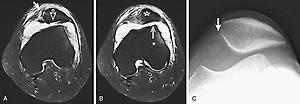
On MRI, the patella may be laterally tilted or laterally subluxed, and there is often a joint effusion or hemarthrosis ( Figs. 12.2 and 12.3 ). MRI also depicts the extent and location of characteristic bone and soft tissue injuries, which include bone contusion; chondral/osteochondral injury; injury of the medial patellar retinacular complex, including the medial patellofemoral ligament; and injury of the vastus medialis obliquus muscle.
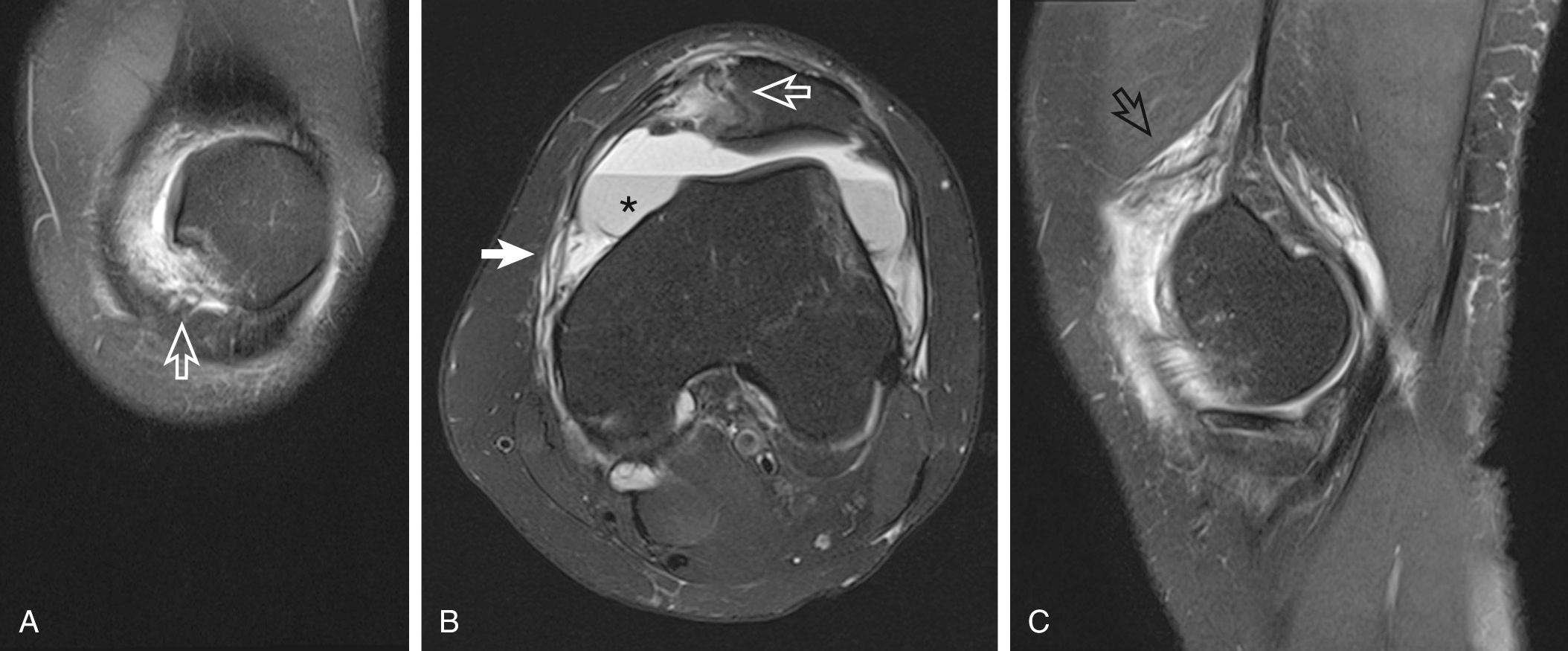
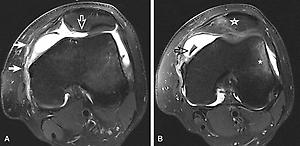
The characteristic anterolateral, nonarticular femoral condylar and medial patellar bone contusions related to translational injury are manifest by increased marrow signal on fluid sensitive sequences or decreased marrow signal on T1 weighted sequences (see Fig. 12.1 ). These may be associated with depression of the overlying cortical or subchondral bone.
At shallow flexion angles, the patella is reliant on soft tissue stabilizers for stability. The medial patellar retinaculum, specifically the medial patellofemoral ligament and vastus medialis obliquus (VMO) muscle, contribute important static and dynamic soft tissue stability to the patella.
The medial patellar retinaculum is a complex of structures that includes the patellotibial, patellomeniscal, and medial patellofemoral ligaments. It receives a fibrous expansion from vastus medialis. The medial patellofemoral ligament (MPFL) is considered most important in providing restraint to lateral patellar displacement and is injured in 97% of acute patellar dislocations.
The MPFL is located within the second anatomic layer of the three-layered fascial structure of the medial knee. It is widest at its broad origin from the upper two-thirds of the patella. Although there is variation as to the site of the femoral insertion of the MPFL in anatomic studies in the literature, * more recent studies have shown it to insert on the femur posterior to the medial epicondyle and distal to the adductor tubercle. Furthermore, Baldwin's cadaveric study revealed both a bony and soft tissue origin of the MPFL: distal transverse fibers from a bony groove between the adductor tubercle and medial epicondyle, and proximal oblique fibers from the edge of the medial collateral ligament. Both fiber groups joined the VMO tendon and formed a conjoint structure that inserted along the upper two-thirds medial border of the patella.
* References .
On MRI, the MPFL is best seen on axial images. It is a well-defined low signal intensity band that arises from the upper patella and courses over the femoral origin of the medial collateral ligament to its insertion; it may be inseparable from the VMO muscle along part of its course. Complete tears are manifest by full thickness discontinuity of the ligament and local soft tissue edema seen as increased or fluid signal on MRI. Partial tears are manifest by partial thickness ligament disruption or irregularity of the ligament in association with soft tissue edema ( Fig. 12.4 ). The MPFL can be injured at its patellar origin (see Fig. 12.1 ), at or near its femoral insertion (see Figs. 12.2 and 12.3 ), at its midsubstance, or in more than one location.
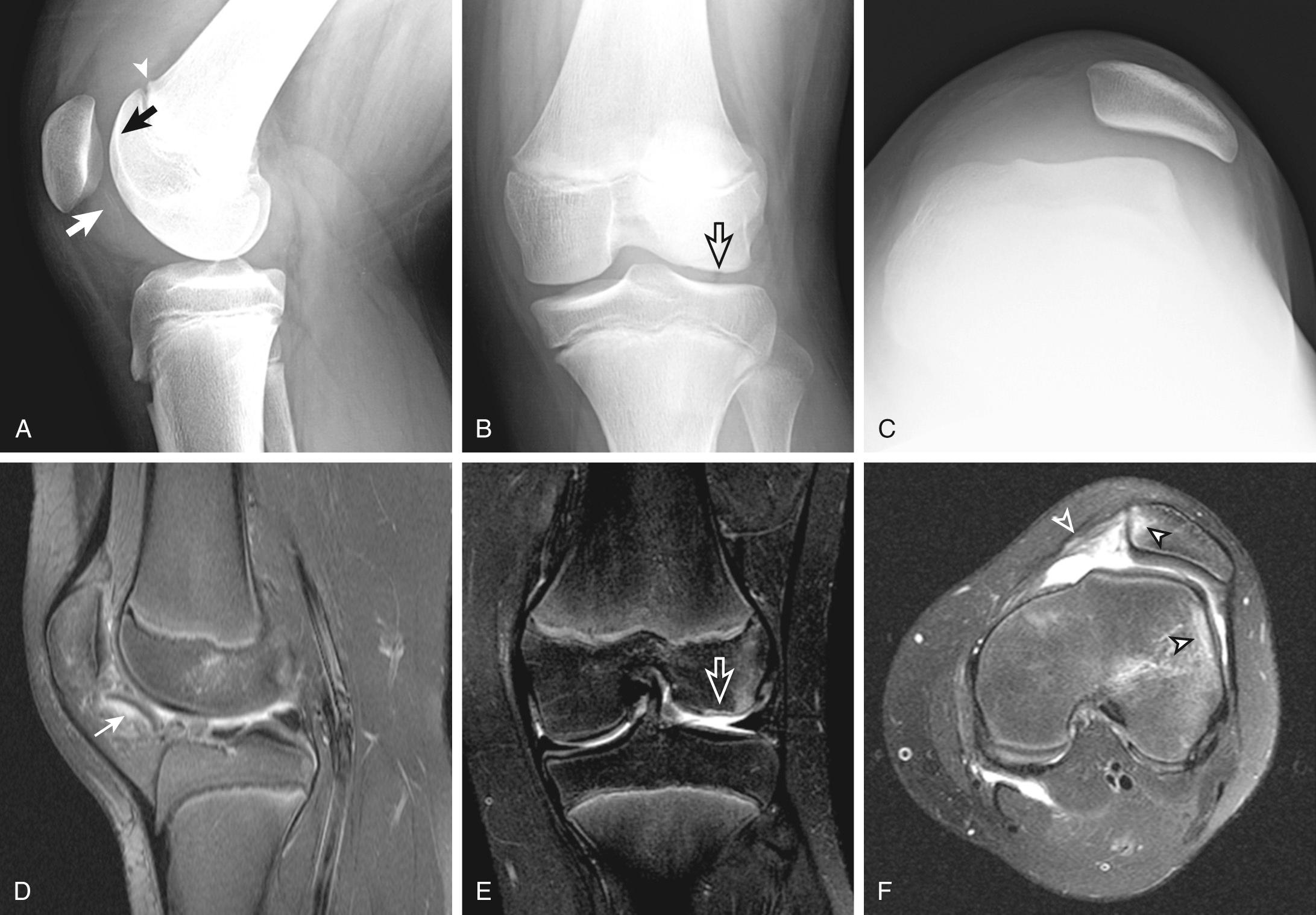
MR is reported to be 85% sensitive and 80% accurate in detecting MPFL injury and has been found to be better than arthroscopy at detecting injuries at its femoral insertion.
MPFL injury is often associated with stripping and elevation of vastus medialis obliquus muscle from its adductor tubercle attachment. Edema and hemorrhage along the inferior border of the VMO are best appreciated on sagittal images (see Fig. 12.2 ).
Patellar, trochlear, and lateral femoral condylar chondral/osteochondral injuries are reported to occur in up to 95% following LPD. These are often radiographically occult. MR has been shown to be highly sensitive and specific for the detection of high-grade cartilage lesions in the setting of LPD.
There are two sites of patellar cartilage injury: at the median ridge related to dislocation, and at the inferomedial patellar facet related to patellar relocation. Injuries to the median ridge patellar articular cartilage are related to shear and can result in a partial or full thickness injury (see Figs. 12.1 and 12.5 ). Injuries at the inferomedial patella are related to impaction and can result in a concave osteochondral injury (see Figs. 12.1, 12.2, 12.4, and 12.5 ); this finding was shown to be 44% sensitive and 100% specific for LPD.
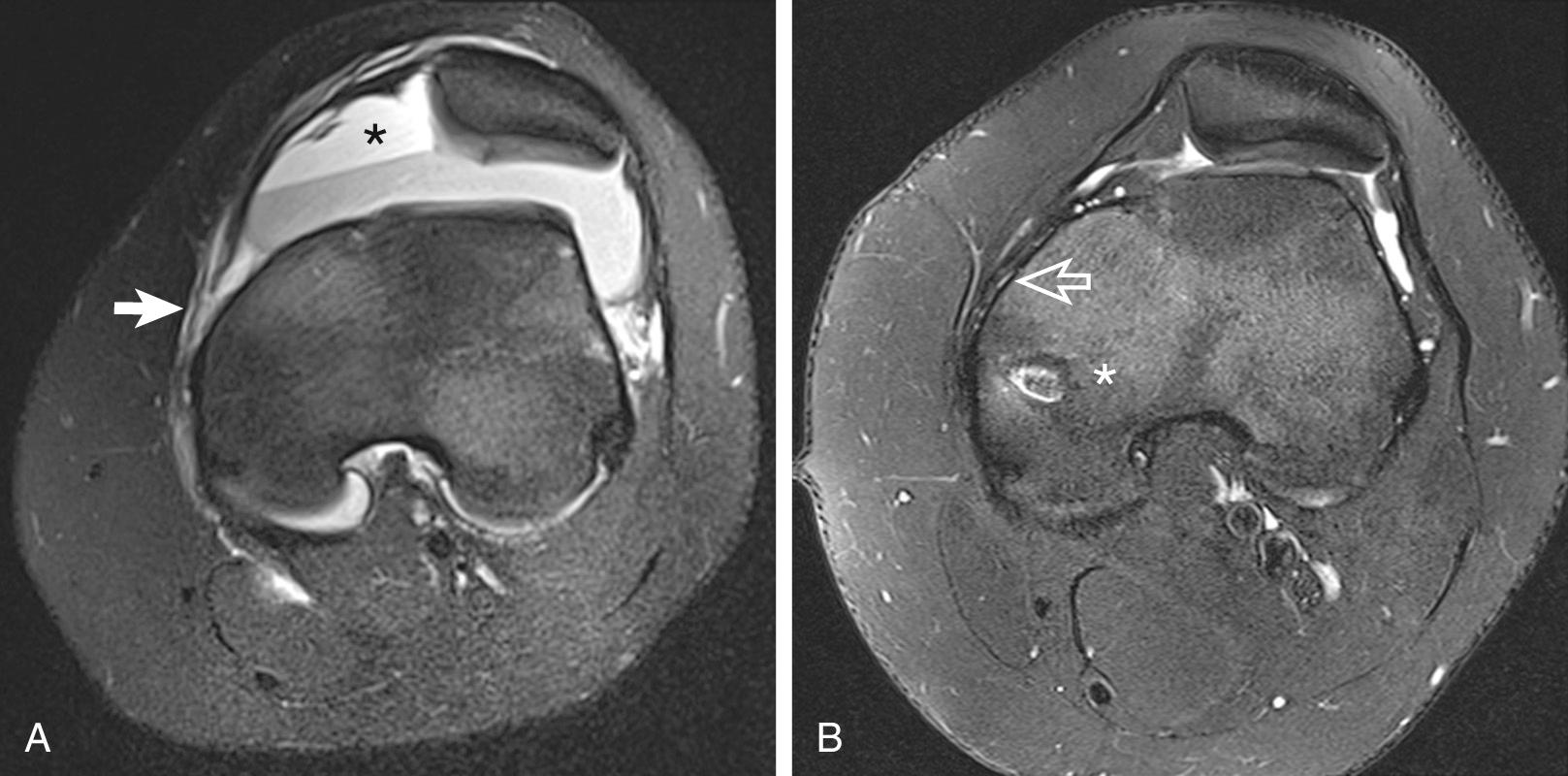
Femoral cartilage injuries are less common than patellar cartilage injuries and occur in two distinct and separate regions. Those that occur along the lateral femoral trochlea are thought to be secondary to shear injury. These full or partial thickness articular cartilage defects of the femoral trochlea are best appreciated on axial images (see Fig. 12.1 ). Osteochondral injuries can also occur along the central surface of the midlateral femoral condyle. These injuries of weight-bearing femoral condylar articular cartilage are likely the result of pivot-shift mechanism of injury and are best seen on coronal and sagittal images (see Fig. 12.4 ). In Zlatkin's study, 50% of patients had osteochondral injuries of the lateral femoral condyle, 30% had osteochondral injuries of the femoral trochlea, and 20% had both.
Patellar dislocation commonly occurs in anatomically predisposed knees. Increased risk of LPD has been associated with patella alta, trochlear dysplasia (TD), abnormal patellar morphology, lateral patellar displacement, increased Q angle with lateralized tibial tuberosity, genu valgum, vastus medialis muscle hypoplasia, ligament hyperlaxity, external tibial torsion, subtalar joint pronation, and increased femoral anteversion. Individuals who suffer from recurrent dislocation have been shown to have more than one anatomic risk factor. Patella alta, TD, and increased tibial tubercle-trochlear groove (TT-TG) distance can be evaluated on a routine MR examination of the knee.
Become a Clinical Tree membership for Full access and enjoy Unlimited articles
If you are a member. Log in here